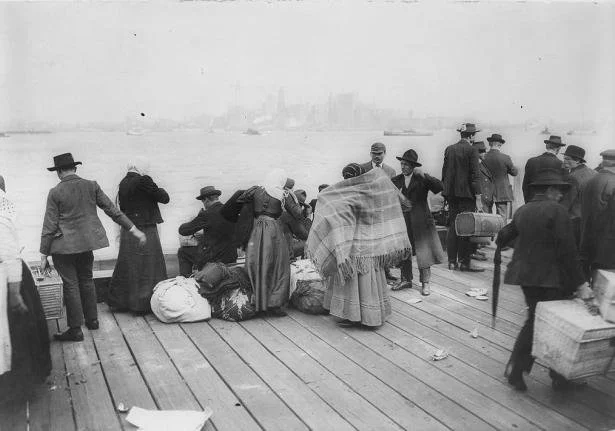The Immigrants Are the Same — America Is Different



Immigrants waiting to be transferred, Ellis Island, October 30, 1912,Library of Congress's Prints and Photographs division (This work is in the public domain in the United States because it was published (or registered with the U.S. Copyright Office) before January 1, 1928.)
The immigrants haven’t really changed since the Ellis Island days — but America has. In 1923, immigrants did not need a visa, or any other sort of prior permission, to enter the United States.
by Razvan Sibii
While the vast majority of Americans have long given up on preventing the spread of COVID-19, the Biden administration found it convenient to keep alive a Trump-era regulation that speeds up the deportation of asylum-seekers under the pretext that they might be bringing the coronavirus into the country.
That is, until last week, when that regulation, called Title 42, expired, and the government found itself forced to once again give asylum-seekers the due process they are legally entitled to.
The already high number of immigrants seeking entry into the U.S. is expected to rise sharply, setting off the usual race between politicians to define the situation as either a “dangerous crisis” or a “manageable challenge.” As always, what is lost in the shuffle are the stories that those immigrants are carrying with them.
Here’s a quick extract from one immigrant’s story:
“When we got [to America], I went one way and my family went another. I don’t know what happened to them. They brought me to the hospital. I was there for 23 days. My sisters, with my father and mother, went to Pennsylvania. My father had to pay a $250 bond that he would return to get me. I wanted my mother. I was crying when they got me. There were two men that brought me into the hospital. I was kicking and screaming and after a while I got tired [...]. Nobody told me anything. Nobody explained, nobody ever said a word to me for 23 days. Just the nurse that came in and took my temperature. She gave me medicine. That’s all I saw was the nurses. [...] At night was the only time I would run away from my room, because during the day I was afraid they would holler, the male and female nurses, whoever was there. They would holler if I’d try to get out, but I never stayed in bed. I had two lumps, the size of walnuts in my throat. They said it was contagious, but I think they forgot me after a while. Then my mother got a telegram to come and get me.”
As you might have guessed, this is not actually the testimony of a recent arrival to the United States. Rather, it’s the testimony of a Sicilian immigrant who came through Ellis Island in 1923 at age 10. (The paragraph is taken from Peter Morton Coan’s 1997 “Ellis Island Interviews”). But replace “a $250 bond” with “a $4,250 bond” and “a telegram” with “a phone call,” and this narrative could easily have come from any one of the thousands of Guatemalan or Honduran kids currently on the cusp of what might end up being the most consequential moment of their young lives.
The family of the Sicilian lady I quoted above simply made its way to the port city of Palermo, got on a boat, and arrived in New York 13 days later. At Ellis Island, they were checked for diseases and asked a few questions about who they were and what they intended to do in the U.S. Interestingly, they were also asked if they had come to America “because of solicitation or offer of employment,” as that would have been grounds for immediate deportation.
These days, a Haitian immigrant who gets on a boat and arrives off the coast of Florida can expect to be turned back immediately. However, having an “offer of employment” from an American company is a good thing, as it can lead to a work visa — but only if the visa quota for your country of origin has not already been filled.
The “Should we stay or should we go?” decision facing immigrants is the same it ever was. It’s the immigration system that awaits them as they approach the U.S. border that has become unbelievably complicated, confusing and even contradictory.
“I don’t think people understand that the rules have changed. I don’t think they relate on a human level with refugees and immigrants, and they don’t understand their stories,” said Darlene Lynch, an attorney and spokesperson for the Georgia office of the Center for Victims of Torture, and organization that advocates for the rights of immigrants.
“We have lawmakers, for instance, who meet a client of ours [who is a refugee]. The conservative lawmaker who loves business meets the [refugee] business guy from wherever who was thrown in jail because he complained about corruption, and then went on this incredibly brave and difficult journey to save himself and his family. And then he came here and all he wants to do is work. What’s not to like about this guy? And so when we introduce an actual person to some of these folks who have these bad ideas [about immigration], they come around pretty quickly,” Lynch said.
The Italian lady who came to America in 1923 bought a dressmaking factory 36 years later and employed 28 workers. Her passage from central Sicily to Palermo to Ellis Island to New York City was not by no means easy, as evidenced by her recollections. But her potential was recognized by a country that wanted her.
If only that country also recognized the same potential in the Honduran lady who this morning faced a stern-looking immigration agent who asked her for a myriad of documents her Sicilian counterpart never had to produce to be given refuge.


